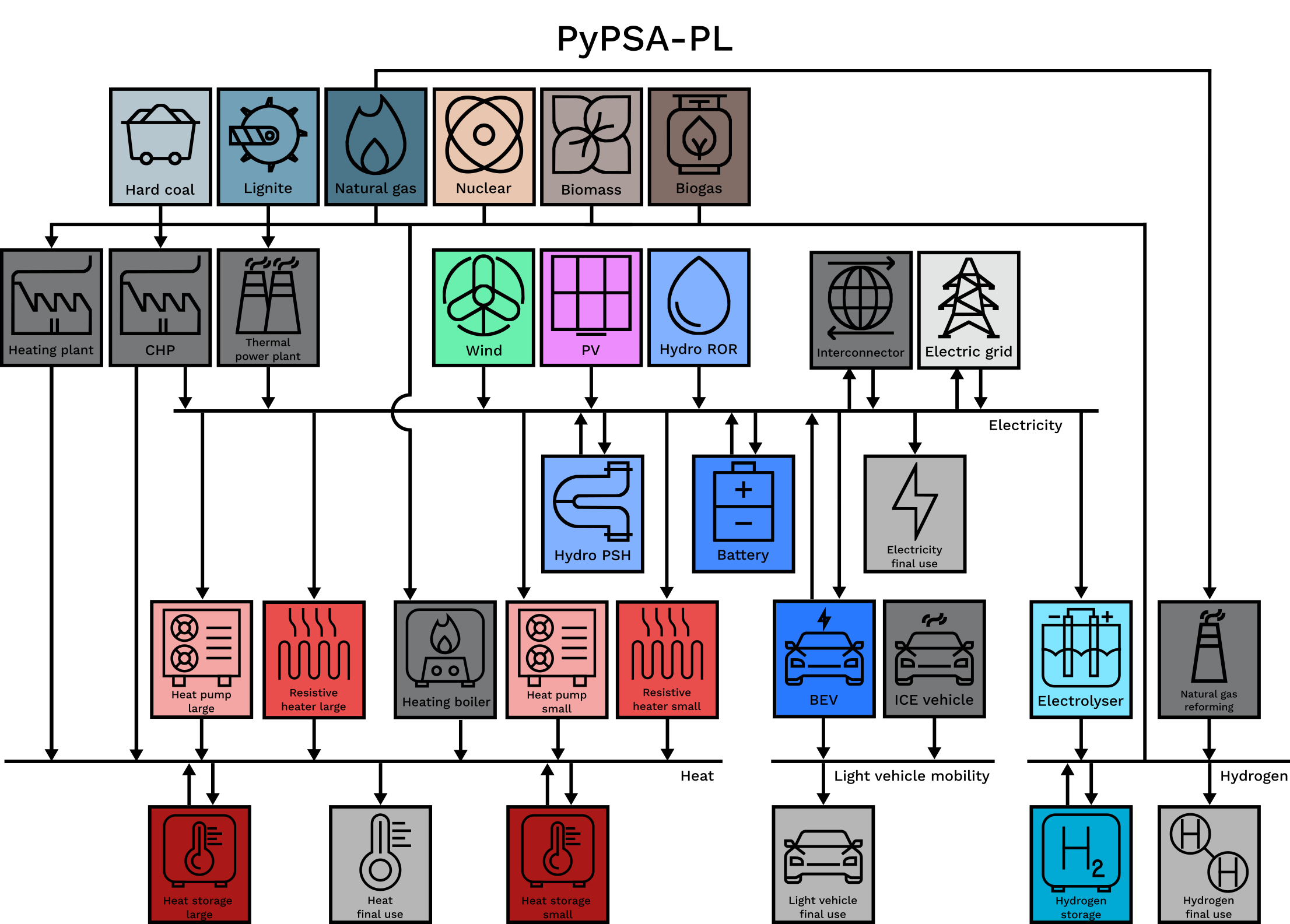PyPSA-PL is an implementation of the energy modelling framework PyPSA shipped with a use-ready dataset tailored for the Polish energy system. PyPSA-PL can be used to plan optimal investments in the power, heating, hydrogen, and light vehicle sectors – given the final use demand together with capital and operation costs for assets – or just to optimise the hourly dispatch of the utility units – given the final use demand and operation costs only. That makes it a useful tool to investigate the feasibility of decarbonisation scenarios for the Polish energy system in which a large share of electricity is supplied by intermittent sources like wind and solar.
PyPSA-PL has been developed and tested using Python 3.10. The project dependencies can be installed using the Poetry according to the pyproject.toml file. Alternatively, you can use any other Python package manager - the dependencies are also listed in the requirements.txt file. Additionally, you will need to install an external solver (see PyPSA manual).
The sample output data that is part of this repository have been generated using HiGHS v1.5.3 solver (with the default settings, the run takes about 30 minutes of computing time and up to 5 GB of RAM on a virtual machine). You can generate the sample output data yourself by running the scripts/run_default.py script. You can use this script as a starting point for your analyses.
The user guide provides an overview of PyPSA-PL structure, data requirements, and selected methodological details.
This table lists the main data sources used for each input category. More detailed source attribution can be found in the input spreadsheets themselves.
| Input | Source |
|---|---|
| installed capacity | ARE. (2023). Wynikowe informacje statystyczne. Agencja Rynku Energii. https://www.are.waw.pl/badania-statystycznewynikowe-informacje-statystyczne PSE. (2023). Zasoby wytwórcze—Wg stanu na 2022.01.01. Informacje o zasobach wytwórczych KSE. Polskie Sieci Elektronergetyczne. https://www.pse.pl/dokumenty?safeargs=666f6c64657249643d3333393139# URE. (2022). Instalacje odnawialnych źródeł energii. Urząd Regulacji Energetyki. https://www.ure.gov.pl/pl/oze/potencjal-krajowy-oze/8108,Instalacje-odnawialnych-zrodel-energii-stan-na-31-grudnia-2021-r.html URE. (2023). Energetyka cieplna w liczbach. Urząd Regulacji Energetyki. https://www.ure.gov.pl/pl/cieplo/energetyka-cieplna-w-l |
| thermal units | Charkowska, Z., Przedlacki, W., Hetmański, M., Swoczyna, B. (2022). Database of thermal power plants and combined heat-and-power plants in Poland. Instrat. https://instrat.pl/en/power-plants-database-for-poland-expanded |
| fuel and CO2 prices | IEA. (2022). World Energy Outlook 2022. IEA. https://www.iea.org/reports/world-energy-outlook-2022 |
| technology data | DAE. (2023). Technology Data. Danish Energy Agency. https://ens.dk/en/our-services/projections-and-models/technology-data |
| final use demand for energy carriers | Kubiczek, P. (2023). Instrat demand model. Instrat. https://github.com/instrat-pl/instrat-demand-model |
| electric load time series | ENTSO-E. (2023). Total Load—Day Ahead / Actual. Transparency Platform. https://transparency.entsoe.eu/load-domain/r2/totalLoadR2/show |
| wind and PV utilisation time series | De Felice, M. (2022). ENTSO-E Pan-European Climatic Database (PECD 2021.3) in Parquet format. Zenodo. https://doi.org/10.5281/zenodo.7224854 Gonzalez-Aparicio, I., Zucker, A., Careri, F., Monforti, F., Huld, T., Badger, J. (2021). EMHIRES dataset: Wind and solar power generation. Zenodo. https://doi.org/10.5281/zenodo.4803353 |
| cross-border transmission capacity | ENTSO-E. (2023). TYNDP 2022 Project Collection. https://tyndp2022-project-platform.azurewebsites.net/projectsheets/transmission |
| installed capacity - neighbour countries | ENTSO-E & ENTSO-G. (2022). TYNDP 2022 Scenario Report. https://2022.entsos-tyndp-scenarios.eu/download |
Here you can find the list of publications based on the PyPSA-PL results and links to the full datasets stored in Zenodo.
- Kubiczek P., Smoleń M. (2023). Poland cannot afford medium ambitions. Savings driven by fast deployment of renewables by 2030. Instrat Policy Paper 03/2023. https://instrat.pl/pypsa-march-2023/
- Kubiczek P. (2023). Baseload power. Modelling the costs of low flexibility of the Polish power system. Instrat Policy Paper 04/2023. https://instrat.pl/baseload-power/
- Kubiczek, P., Smoleń, M., Żelisko, W. (2023). Poland approaching carbon neutrality. Four scenarios for the Polish energy transition until 2040. Instrat Policy Paper 06/2023. https://instrat.pl/poland-2040/
The current version of PyPSA-PL is a successor of the PyPSA-PL v1 developed by the Instrat Foundation in 2021. The following publications were based on the PyPSA-PL v1 results:
- Czyżak, P., Wrona, A. (2021). Achieving the goal. Coal phase-out in Polish power sector. Instrat Policy Paper 01/2021. https://instrat.pl/coal-phase-out
- Czyżak, P., Sikorski, M., Wrona, A. (2021). What’s next after coal? RES potential in Poland. Instrat Policy Paper 06/2021. https://instrat.pl/res-potential
- Czyżak, P., Wrona, A., Borkowski, M. (2021). The missing element. Energy security considerations. Instrat Policy Paper 09/2021. https://instrat.pl/energy-security
The code is released under the MIT license. The input and output data are released under the CC BY 4.0 license.
© Instrat Foundation 2023

